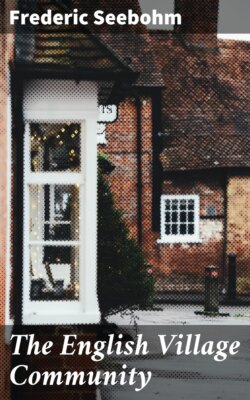Читать книгу The English Village Community - Frederic Seebohm - Страница 25
На сайте Литреса книга снята с продажи.
VIII. THE RELATION OF THE VIRGATE TO THE HIDE TRACED IN THE CARTULARIES OF GLOUCESTER AND WORCESTER ABBEYS, AND THE CUSTUMAL OF BLEADON, IN SOMERSETSHIRE.
ОглавлениеTable of Contents
Gloucester surveys of 1266.
Further facts relating to the hide and the virgate are elicited by extending the inquiry into the west of England. Turning to the cartulary of the monastery of St. Peter at Gloucester,56 there are several 'extents' of manors in the west of England of about the year 1266, which give valuable evidence, not only of the existence of the open fields divided into three fields or seasons, furlongs, and half-acre strips, but also as regards the holdings.
The virgates in this district varied in acreage, some containing 48 acres, others 40, 38, 36, and 28 acres respectively.57 In one case it is incidentally mentioned that 4 virgates make a hide.58 We have thus in these extents evidence both of the prevalence and of the varying acreage of the virgate in the extreme west of England, to add to the evidence already obtained in respect of the midland counties.
Worcester surveys of 1240.
So also the register of the Priory of St. Mary, Worcester,59 dated 1240, affords still earlier evidence for the west of England of a similar kind. [p056]
In the first manor mentioned therein the customary services of the villeins are described as pertaining to each pair of half-virgates, i.e. to each original virgate.60 In the next manor there were 35 holdings in half-virgates, and so in other manors.61 It is sometimes mentioned how many acres in each field belong to the several half-virgates, thus showing not only the division of the fields into seasons, but the scattered contents of the holdings.
Finally, with local variations serfdom in these two western counties was almost identical with that in other parts of England.
Two examples of the services of holders of virgates and half-virgates respectively are appended as before for comparison with others, and also examples of the services of cottier tenants. The list given in the note below of the 'common customs' of the villein tenants of one of the manors of Worcester Priory, describes some of the more general incidents of villenage, and shows how thorough a serfdom it originally was.62 [p057]
Custumal of Bleadon, in Somersetshire.
To this evidence from the counties of Worcester and Gloucester we may add the evidence of the Custumal of Bleadon, in Somersetshire, also dating from the thirteenth century.
The manor belonged to the Prior of St. Swithin, at Winchester. There were very few libere tenentes. The tenants in villenage were virgarii, or holders of virgates, and dimidii-virgarii, or holders of half-virgates. There were also holders of fardels or quarter-virgates, and half-fardels, or one-eighth-virgates, and other small cottier tenants. Four virgates went to the hide. And the services were very similar to those of the Gloucester and Worcester tenants. They are described at too great length to be inserted here. We may, however, notice the importance amongst other items of the carrying service or averagium—a service often mentioned among villein services, but here defined with more than usual exactness.63
In short, without going further into details, it is obvious that the open field system and the serfdom which lived within it were practically the same in their general features in the west and in the east of England.
The following are the examples of the services in Gloucestershire and Worcestershire:—[p058]
